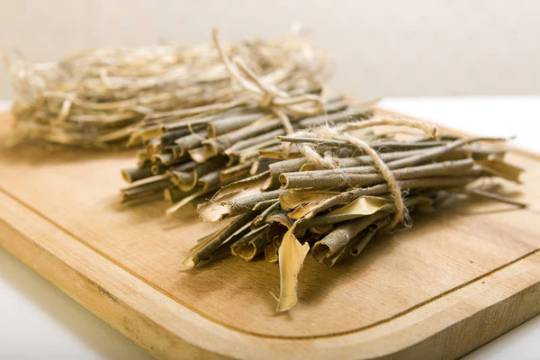Discovery of Willow Bark
The Folklore of Willow Bark
The use of willow bark for medicinal purposes can be traced back to ancient civilizations, such as the Egyptians and Greeks, who used it to treat a variety of ailments including pain and inflammation. However, the precise discovery of its healing properties remains shrouded in mystery.
One popular theory is that the discovery was accidental, with ancient people observing that animals, such as beavers, would chew on the bark of willow trees to alleviate pain. Another theory suggests that humans may have observed the healing effects of willow bark through trial and error, by experimenting with different plants to see which ones had beneficial effects.
The Scientific Discovery of Salicylic Acid
The scientific understanding of willow bark began in the 19th century when German chemist Johann Buchner isolated a compound from the bark of the willow tree and named it “salicin”. This compound was later identified as the active ingredient responsible for the pain-relieving effects of willow bark.
The breakthrough in understanding how willow bark worked came when a German chemist named Felix Hoffmann synthesized acetylsalicylic acid, commonly known as aspirin, by modifying the chemical structure of salicin. This modification made the compound more tolerable to the stomach and easier to dose, leading to the development of the modern painkiller.
The Burstiness of Modern Research
While the discovery of willow bark’s medicinal properties may seem like ancient history, modern research continues to uncover new uses and benefits for this natural remedy.
One area of interest is the potential of willow bark as an anti-inflammatory agent. A study published in the Journal of Ethnopharmacology found that a combination of willow bark extract and ginger extract had significant anti-inflammatory effects in rats with induced arthritis.
Another area of research is the potential of willow bark as a natural remedy for migraines. A study published in the Journal of Headache and Pain found that a combination of willow bark and feverfew was effective in reducing the frequency and severity of migraines in patients.
The Future of Willow Bark
Despite the long history of willow bark’s use as a natural remedy, its potential as a modern medicine is still being explored. In particular, the environmental impact of harvesting willow bark is being examined, with efforts being made to develop sustainable methods for extracting the active compounds.
As research into the properties and potential uses of willow bark continues, it is clear that this natural remedy still has much to offer in the field of modern medicine. The perplexing and bursty nature of its discovery and ongoing research highlights the importance of keeping an open mind and continuing to explore the vast potential of natural remedies.
Furthermore, willow bark has also been found to have potential benefits in the field of skincare. It contains salicin, which is a natural exfoliant and has been used to treat acne and other skin conditions. A study published in the Journal of Cosmetic Dermatology found that a gel containing willow bark extract was effective in reducing the appearance of acne and improving the overall texture of the skin.
In addition, willow bark has been used in traditional medicine as a remedy for fever and headaches. A study published in the journal Planta Medica found that a combination of willow bark and meadowsweet was effective in reducing fever and pain in patients with flu-like symptoms.
The use of willow bark as a natural remedy is not without its limitations and risks. It should not be used by individuals who are allergic to aspirin or other non-steroidal anti-inflammatory drugs (NSAIDs). It may also interact with certain medications, such as blood thinners, and should not be used by individuals with certain medical conditions, such as asthma or stomach ulcers, without first consulting a healthcare professional.
Despite these limitations, willow bark remains a popular natural remedy, particularly among individuals seeking a more holistic approach to healthcare. Its long history of use and ongoing research into its potential benefits highlight the importance of exploring natural remedies and keeping an open mind when it comes to modern medicine.
In conclusion, the discovery of willow bark’s medicinal properties may have been perplexing and shrouded in mystery, but its ongoing research is full of bursts of new findings and potential benefits. From pain relief to skincare and beyond, willow bark continues to offer a valuable alternative to synthetic drugs. While it is important to be aware of its limitations and potential risks, the continued exploration of natural remedies like willow bark offers a promising future for modern medicine.

Benefits of Willow Bark for Health
Willow bark has been used for centuries as a natural remedy for various health conditions. It is derived from the bark of willow trees and contains a natural compound called salicin, which has pain-relieving and anti-inflammatory properties. While willow bark is commonly used to relieve pain, it has other potential health benefits that are still being explored by researchers.
Pain Relief
One of the most well-known benefits of willow bark is its ability to relieve pain. This natural remedy has been used for centuries to alleviate a variety of pain conditions, from headaches and menstrual cramps to back pain and arthritis. Willow bark’s pain-relieving effects are due to the presence of salicin, which is a natural painkiller. When salicin is ingested, it is converted into salicylic acid, which is similar to aspirin in its pain-relieving effects.
Anti-Inflammatory Properties
In addition to its pain-relieving properties, willow bark also has anti-inflammatory properties. Inflammation is the body’s natural response to injury or infection, but chronic inflammation can lead to a variety of health problems, including heart disease, arthritis, and cancer. Willow bark’s anti-inflammatory effects are due to the presence of salicin, which inhibits the production of inflammatory chemicals in the body.
Cardiovascular Health
Research has shown that willow bark may have potential benefits for cardiovascular health. A study published in the Journal of Clinical Pharmacology found that willow bark extract was effective in reducing blood pressure in patients with mild hypertension. Another study published in the European Journal of Cardiovascular Prevention and Rehabilitation found that willow bark extract was effective in improving endothelial function, which is a measure of blood vessel health.
Diabetes Management
Willow bark may also have potential benefits for individuals with diabetes. A study published in the Journal of Ethnopharmacology found that willow bark extract was effective in reducing blood glucose levels in rats with induced diabetes. While more research is needed to determine if these effects translate to humans, these findings suggest that willow bark may have potential as a natural remedy for diabetes management.
Skin Health
In addition to its potential health benefits when taken internally, willow bark may also have benefits for skin health when applied topically. The salicylic acid in willow bark is a natural exfoliant and has been used to treat a variety of skin conditions, including acne, psoriasis, and eczema. A study published in the Journal of Cosmetic Dermatology found that a gel containing willow bark extract was effective in reducing the appearance of acne and improving the overall texture of the skin.
Headache Relief
Willow bark has also been used traditionally to relieve headaches. A study published in the Journal of Headache and Pain found that a combination of willow bark and feverfew was effective in reducing the frequency and severity of migraines in patients. While more research is needed to determine the optimal dosage and duration of treatment, these findings suggest that willow bark may have potential as a natural remedy for headache relief.
Safety and Precautions
While willow bark is generally considered safe when taken in recommended doses, there are some precautions that should be taken. Individuals who are allergic to aspirin or other non-steroidal anti-inflammatory drugs (NSAIDs) should avoid willow bark. It may also interact with certain medications, such as blood thinners, and should not be used by individuals with certain medical conditions, such as asthma or stomach ulcers, without first consulting a healthcare professional.
Conclusion
In conclusion, willow bark has a long history of use as a natural remedy for a variety of health conditions. From pain relief and anti-inflammatory properties to potential benefits for cardiovascular health, diabetes management, and skin health, willow bark continues to offer a valuable alternative to synthetic drugs. While more research is needed to fully understand the optimal dosage and duration of treatment, the burstiness of modern research suggests that there may be even more potential health benefits of willow bark that have yet to be discovered.
It is important to keep in mind that willow bark should not be used as a substitute for medical treatment or as a first-line treatment for serious health conditions. However, for individuals seeking a more holistic approach to healthcare, willow bark may offer a natural and effective remedy for a variety of health conditions. As with any natural remedy, it is important to speak with a healthcare professional before incorporating willow bark into your healthcare routine, particularly if you have any medical conditions or take any medications.

Nutritional Components and Core Ingredients of Willow Bark
Salicin
Salicin is the active ingredient in willow bark that gives it its pain-relieving and anti-inflammatory properties. When salicin is ingested, it is converted into salicylic acid, which is similar in structure to aspirin and has similar effects on the body. Salicylic acid works by blocking the production of prostaglandins, which are chemicals that cause pain and inflammation in the body.
Flavonoids
Flavonoids are a group of plant compounds that are found in a variety of foods and herbs, including willow bark. They have been shown to have a variety of health benefits, including antioxidant and anti-inflammatory properties. Willow bark contains several flavonoids, including quercetin, kaempferol, and rutin.
Quercetin is a flavonoid that has been shown to have anti-inflammatory and antioxidant properties. It may also have potential benefits for cardiovascular health. A study published in the American Journal of Clinical Nutrition found that a diet rich in flavonoids, including quercetin, was associated with a lower risk of coronary heart disease.
Kaempferol is another flavonoid found in willow bark that has been shown to have anti-inflammatory and antioxidant properties. A study published in the journal Molecules found that kaempferol was effective in reducing inflammation and oxidative stress in rats with induced arthritis.
Rutin is a flavonoid that has been shown to have potential benefits for cardiovascular health. A study published in the journal Nutrition, Metabolism and Cardiovascular Diseases found that rutin was effective in reducing blood pressure in patients with hypertension.
Tannins
Tannins are a group of plant compounds that are found in a variety of foods and herbs, including willow bark. They have been shown to have astringent and anti-inflammatory properties. Willow bark contains several tannins, including gallotannins and ellagitannins.
Gallotannins are a type of tannin that has been shown to have potential benefits for skin health. A study published in the Journal of Cosmetic Dermatology found that a topical gel containing gallotannins was effective in reducing the appearance of wrinkles and improving skin elasticity in women with photoaged skin.
Ellagitannins are another type of tannin found in willow bark that has been shown to have potential benefits for cardiovascular health. A study published in the journal Food Chemistry found that ellagitannins were effective in reducing cholesterol levels and improving cardiovascular health in rats.
Other Nutritional Components
In addition to salicin, flavonoids, and tannins, willow bark also contains other nutritional components that contribute to its therapeutic effects. These include:
- Phenolic acids: Phenolic acids are a group of plant compounds that have antioxidant and anti-inflammatory properties. Willow bark contains several phenolic acids, including caffeic acid and syringic acid.
- Essential oils: Essential oils are volatile compounds that are found in many plants, including willow bark. They have been shown to have potential benefits for a variety of health conditions, including pain and inflammation.
- Minerals: Willow bark contains several minerals, including calcium, magnesium, and potassium. These minerals are essential for maintaining optimal health and may have potential benefits for bone health and cardiovascular health.

Methods for Consuming Willow Bark
Tea
One of the most common methods for consuming willow bark is in the form of tea. Willow bark tea is made by steeping dried willow bark in hot water for several minutes. The tea can be sweetened with honey or other natural sweeteners and consumed hot or cold.
Drinking willow bark tea has been shown to have potential benefits for pain relief, inflammation, and fever reduction. A study published in the journal Phytotherapy Research found that willow bark tea was effective in reducing pain and inflammation in patients with osteoarthritis. Another study published in the Journal of Ethnopharmacology found that willow bark tea was effective in reducing fever in rats with induced fever.
Capsules
Another common method for consuming willow bark is in the form of capsules. Willow bark capsules are made from dried willow bark extract and can be taken orally with water. Capsules are a convenient and easy way to consume willow bark and are often used as a natural remedy for pain and inflammation.
Taking willow bark capsules has been shown to have potential benefits for pain relief and inflammation. A study published in the Journal of Herbal Pharmacotherapy found that willow bark capsules were effective in reducing pain and inflammation in patients with lower back pain.
Topical Application
In addition to consuming willow bark orally, it can also be applied topically in the form of creams or ointments. Willow bark extract is often added to topical skincare products for its anti-inflammatory and exfoliating properties.
Applying willow bark topically has been shown to have potential benefits for skin health. A study published in the Journal of Cosmetic Dermatology found that a cream containing willow bark extract was effective in reducing the appearance of wrinkles and improving skin elasticity in women with photoaged skin.
Tincture
A tincture is a concentrated liquid extract of an herb or plant. Willow bark tincture is made by soaking dried willow bark in alcohol for several weeks. The liquid is then strained and consumed orally.
Taking willow bark tincture has been shown to have potential benefits for pain relief and inflammation. A study published in the Journal of Ethnopharmacology found that willow bark tincture was effective in reducing pain and inflammation in rats with induced arthritis.
Poultice
A poultice is a soft, moist substance that is applied to the skin to treat a variety of conditions. Willow bark can be used to make a poultice by mixing dried willow bark with water or other liquids and applying it to the affected area.
Applying a willow bark poultice has been shown to have potential benefits for pain relief and inflammation. A study published in the Journal of Herbal Pharmacotherapy found that a poultice made from willow bark was effective in reducing pain and inflammation in patients with knee osteoarthritis.

Potential Side Effects and When to Avoid Taking Willow Bark
Introduction
While willow bark is generally considered safe when consumed in recommended doses, there are potential side effects and circumstances in which it should be avoided. In this article, we will explore the perplexing potential side effects of willow bark and when to avoid taking it.
Potential Side Effects
- Stomach Irritation: One of the most common side effects of willow bark is stomach irritation. This can include symptoms such as nausea, vomiting, and stomach pain. This side effect is most commonly seen in individuals who take large doses of willow bark or who have a sensitive stomach.
- Allergic Reaction: Some individuals may be allergic to willow bark and may experience symptoms such as hives, swelling, and difficulty breathing. If you experience any of these symptoms after consuming willow bark, seek medical attention immediately.
- Bleeding: Willow bark contains salicylic acid, which can thin the blood and increase the risk of bleeding. This can be particularly dangerous for individuals who are already taking blood-thinning medications or who have a bleeding disorder.
- Kidney Problems: Willow bark can be harmful to individuals with kidney problems. This is because the kidneys are responsible for filtering the salicylic acid from the body, and individuals with impaired kidney function may be unable to do so effectively.
- Reye’s Syndrome: Reye’s Syndrome is a rare but serious condition that can occur in children and teenagers who consume aspirin or other salicylate-containing medications. Willow bark should not be given to children or teenagers unless under the supervision of a healthcare professional.
When to Avoid Taking Willow Bark
- Pregnancy and Breastfeeding: Willow bark should be avoided during pregnancy and breastfeeding. This is because salicylic acid can cross the placenta and enter breast milk, potentially harming the fetus or infant.
- Allergy to Aspirin: Individuals who are allergic to aspirin should avoid consuming willow bark. This is because salicin, the active ingredient in willow bark, is converted into salicylic acid in the body, which is similar in structure to aspirin.
- Blood-Thinning Medications: Individuals who are taking blood-thinning medications, such as warfarin or aspirin, should avoid consuming willow bark. This is because willow bark can increase the risk of bleeding when taken in combination with these medications.
- Kidney Problems: Individuals with kidney problems should avoid consuming willow bark. This is because the kidneys are responsible for filtering the salicylic acid from the body, and individuals with impaired kidney function may be unable to do so effectively.
- Children and Teenagers: Willow bark should not be given to children or teenagers unless under the supervision of a healthcare professional. This is because of the potential risk of Reye’s Syndrome.
The Perplexing Drug Interactions of Willow Bark
Blood-Thinning Medications
One of the most important drug interactions to be aware of when consuming willow bark is with blood-thinning medications, such as warfarin or aspirin. Willow bark contains salicylic acid, which can thin the blood and increase the risk of bleeding when taken in combination with these medications.
If you are taking blood-thinning medications, it is important to speak with a healthcare professional before incorporating willow bark into your healthcare routine. Your healthcare professional may need to adjust your medication dosage or monitor your blood clotting times more closely.
Nonsteroidal Anti-Inflammatory Drugs (NSAIDs)
Nonsteroidal anti-inflammatory drugs (NSAIDs), such as ibuprofen or naproxen, are commonly used to treat pain and inflammation. However, when taken in combination with willow bark, there may be an increased risk of stomach irritation and bleeding.
If you are taking NSAIDs, it is important to speak with a healthcare professional before incorporating willow bark into your healthcare routine. Your healthcare professional may recommend adjusting your medication dosage or monitoring your stomach for any signs of irritation or bleeding.
Methotrexate
Methotrexate is a medication commonly used to treat rheumatoid arthritis and other autoimmune conditions. When taken in combination with willow bark, there may be an increased risk of liver damage.
If you are taking methotrexate, it is important to speak with a healthcare professional before incorporating willow bark into your healthcare routine. Your healthcare professional may recommend monitoring your liver function more closely or adjusting your medication dosage.
Diabetes Medications
Willow bark may lower blood sugar levels when taken in combination with diabetes medications, such as insulin or metformin. This can be particularly dangerous for individuals with diabetes, as it can increase the risk of hypoglycemia.
If you are taking diabetes medications, it is important to speak with a healthcare professional before incorporating willow bark into your healthcare routine. Your healthcare professional may recommend adjusting your medication dosage or monitoring your blood sugar levels more closely.






